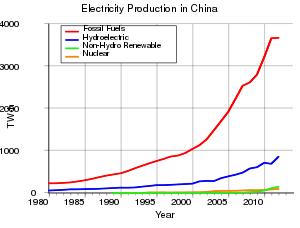This article reads like a press release or a news article and may be largely based on routine coverage. (October 2015) |
China is the world's largest consumer of electricity, and its demand is expected to double by the next decade [when?], and triple by 2035. In 2010, 70 percent of the country's electricity generation came from coal-fired power plants, but the Chinese government is investing heavily in renewable energy technologies. As of 2013, 21 percent of China's electricity generation comes from renewable sources.[1] This represents only 9 percent of overall primary energy consumption in the country. China's latest goal is to increase renewable energy to 9.5 percent of overall primary energy use by 2015. To implement China's new clean energy capacity into the national power grid, and to improve the reliability of the country's existing infrastructure, requires significant upgrades and ultimately, a smart grid.[2]

A smart grid differs from a conventional power grid in that it includes a system of information and communication technologies to bidirectionally transmit and distribute electricity more efficiently and reliably. Additionally, this technology allows consumers to manage their power usage and make choices for economically efficient products and services. China's national utility, the State Grid Corporation of China (SGCC), is responsible for the oversight of these upgrades.
- ^ "China: International energy data and analysis". US Energy Information Administration. Retrieved 15 June 2015.
- ^ "China's Energy Consumption Rises the Wall Street Journal". Wall Street Journal. 2011. Retrieved 11 April 2012.